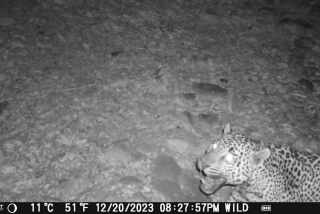NEIGHBORS : Past Digs : An Ojai woman joins Russian students in the former Soviet Union unearthing 5,000-year-old burial mounds.
- Share via
Ojai’s Paula Spellman said it was a mid-life thing.
Some people run marathons, some change jobs. At age 49, Spellman chose to travel 43 1/2 hours to an archeological site near the Kazakhstan border in the former Soviet Union. Once there, she spent 4 1/2 months in 90-degree temperatures helping to dig up 5,000-year-old burial mounds.
“I wanted to do something that would stretch me both physically and emotionally,” she said. “So I went over there and decided this was definitely outside my comfort zone.”
The summer expedition was part of an annual program for students at the University of Moscow. Spellman was one of three Americans who got to accompany the students. The group spent the time unearthing graves--or kurgans--looking for the remains of people known as the Sarmatians.
“It was like the most exciting jigsaw puzzle--when you HAVE to do one more piece,” she said. “There was always one more bone, one more bowl. There was a bowl and a lamb (skeleton) with each body.”
But it wasn’t all fun and games.
The living accommodations were modest. Spellman slept in a 12-foot-high, 12-foot-diameter tent with a cot, sleeping bag, oil lamp and canteen. She ate tasty but “monotonous” food. “We had some grain for every meal,” she said. “Twice I had milk and one time I had cheese, but for the most part it was grains and soups.”
In the Comforts of Home category, Spellman considered herself lucky just to have her own bathroom. “They built an outhouse for me,” she said. “I was very grateful.”
And then there were the rodents. “I finally adjusted to the outhouse. I adjusted to the food, I adjusted to the heat, but when the rat crawled on me at night . . . “ Spellman said, her voice trailing off. “It was mice the next night. They’re different (from mice found here). The mice are darling. They just look at you; they’re not afraid of you. That’s the problem.”
Spellman’s trip was her fourth to that region of the world. For the past 2 1/2 years, she and her family have housed dissident artist Slava Sukhorukov.
What is the root of Spellman’s fascination for the people and culture of the former Soviet Union? The answer can be found in “Nicholas and Alexandra,” Robert K. Massie’s best-selling 1985 book. “After that, I devoured everything,” she said. “I think I have a Russian soul. I don’t know why I identify so strongly.”
There are telltale signs of this strong attachment--aside from the abundance of Sukhorukov paintings on the walls of Spellman’s residence. One need only hear Spellman call her pets. There are two dogs, Baba Yaga (the name of a Russian fairy-tale witch) and Pushkin. The cat’s name is Rimsky.
*
Banned Books Week gets under way Saturday, and once again the Ventura Bookstore on Main Street will celebrate the occasion with an eye-catching window display.
As in past years, banned or challenged books such as “Huckleberry Finn,” “The Grapes of Wrath” and “Of Mice and Men” will take their place in the window for people to ponder.
Unlike past years at the store, however, there will be no “Banned Book” buttons available as souvenirs. Last year, the store had 100 of them, and nearly a third were stolen.
Note: A complaint was filed last year with the Thousand Oaks Library in connection with the children’s book “The Boy Who Lost His Face,” by Louis Sachar. A local father, whose son had read the book, said some of the language was inappropriate for children. Library officials did not take the book off the shelves.
More to Read
Sign up for Essential California
The most important California stories and recommendations in your inbox every morning.
You may occasionally receive promotional content from the Los Angeles Times.










